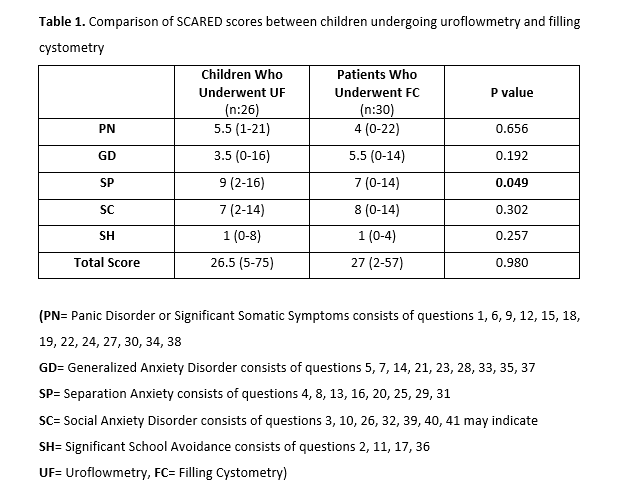Back
Poster, Podium & Video Sessions
Moderated Poster
MP08: Pediatric Urology: Penis & Scrotum
MP08-20: The Comparison of Anxiety Levels in Children Who Underwent Invasive or Non-Invasive Urodynamic Studies
Friday, May 13, 2022
10:30 AM – 11:45 AM
Location: Room 225
Cagri Akin Sekerci, Onur Can Ozkan*, Yiloren Tanidir, Tufan Tarcan, Selcuk Yucel, Istanbul, Turkey
- OO
Poster Presenter(s)
Introduction: Urodynamic studies play an important role in the evaluation of children with lower urinary tract dysfunction. In this study, we aimed to examine the effects of invasive and non-invasive urodynamic studies on the anxiety levels of children with the help of an anxiety scale.
Methods: Children aged 8-17 years who were scheduled for uroflowmetry (UF) or filling cystometry (FC) and who agreed to fill out an anxiety scale were included in the study. It was the first UF or FC of all children. “The Screen for Child Anxiety Related Disorders (SCARED)” form consisting of 41 questions was used in the evaluation. All children included in the study filled the form themselves. The SCARED results of children who underwent UF and FC were compared.
Results: A total of 56 children with a mean age of 10.85+/-2.98 years were included in the study. 31 (55.4%) of the children were females and 25 (44.6%) were males. The number of children who had UF was 26 (46.4%; 8.5 (8-14) years), and 30 (53.6%; 11.5 (8-17) years) had FC. The total SCARED scores of the children who underwent UF and FC were 26.5 (5-75) and 27 (2-57), respectively, and there was no statistical difference (p=0.980) (Table 1). A significant difference was found only in "Separation Anxiety Disorder" among sub-score evaluations (p=0.049) (Table 1). In children who underwent filling cystometry, there was no statistical difference in the total SCARED score between those who did and did not do clean intermittent catheterization (28 (3-41); 27 (2-57), respectively) (p=0.860).
Conclusions: The SCARED scores above 25 indicate an anxiety disorder, and interestingly, in this study, both the invasive and noninvasive urodynamic study groups scored over 25. We consider that non-invasive urodynamic tests may cause stress on children as much as invasive ones.
Source of Funding: No funding

Methods: Children aged 8-17 years who were scheduled for uroflowmetry (UF) or filling cystometry (FC) and who agreed to fill out an anxiety scale were included in the study. It was the first UF or FC of all children. “The Screen for Child Anxiety Related Disorders (SCARED)” form consisting of 41 questions was used in the evaluation. All children included in the study filled the form themselves. The SCARED results of children who underwent UF and FC were compared.
Results: A total of 56 children with a mean age of 10.85+/-2.98 years were included in the study. 31 (55.4%) of the children were females and 25 (44.6%) were males. The number of children who had UF was 26 (46.4%; 8.5 (8-14) years), and 30 (53.6%; 11.5 (8-17) years) had FC. The total SCARED scores of the children who underwent UF and FC were 26.5 (5-75) and 27 (2-57), respectively, and there was no statistical difference (p=0.980) (Table 1). A significant difference was found only in "Separation Anxiety Disorder" among sub-score evaluations (p=0.049) (Table 1). In children who underwent filling cystometry, there was no statistical difference in the total SCARED score between those who did and did not do clean intermittent catheterization (28 (3-41); 27 (2-57), respectively) (p=0.860).
Conclusions: The SCARED scores above 25 indicate an anxiety disorder, and interestingly, in this study, both the invasive and noninvasive urodynamic study groups scored over 25. We consider that non-invasive urodynamic tests may cause stress on children as much as invasive ones.
Source of Funding: No funding


.jpg)
.jpg)